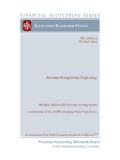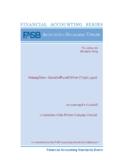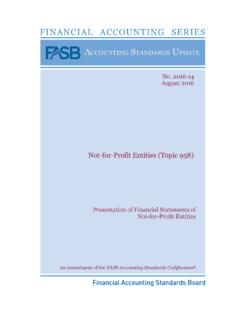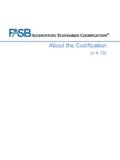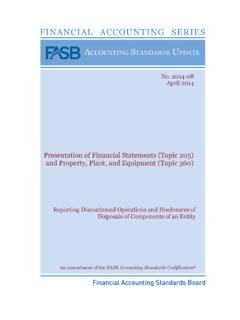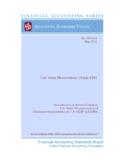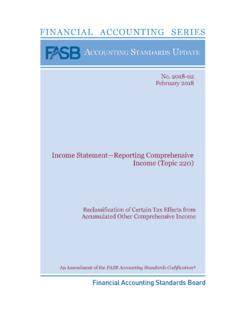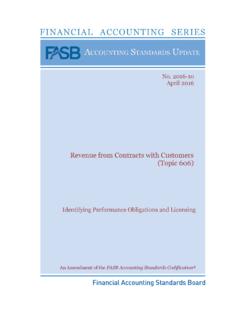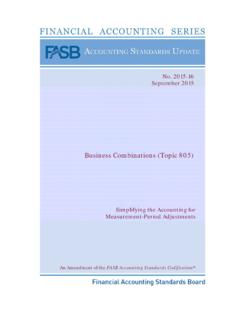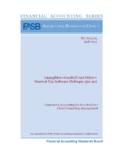Transcription of Interest—Imputation of Interest (Subtopic 835-30)
1 Interest Imputation of Interest (Subtopic 835-30) No. 2015-03 April 2015 Simplifying the Presentation of Debt Issuance Costs An Amendment of the FASB Accounting Standards Codification The FASB Accounting Standards Codification is the source of authoritative generally accepted accounting principles (GAAP) recognized by the FASB to be applied by nongovernmental entities. An Accounting Standards Update is not authoritative; rather, it is a document that communicates how the Accounting Standards Codification is being amended. It also provides other information to help a user of GAAP understand how and why GAAP is changing and when the changes will be effective. For additional copies of this Accounting Standards Update and information on applicable prices and discount rates contact: Order Department Financial Accounting Standards Board 401 Merritt 7 PO Box 5116 Norwalk, CT 06856-5116 Please ask for our Product Code No.
2 ASU2015-03. FINANCIAL ACCOUNTING SERIES (ISSN 0885-9051) is published quarterly by the Financial Accounting Foundation. Periodicals postage paid at Norwalk, CT and at additional mailing offices. The full subscription rate is $242 per year. POSTMASTER: Send address changes to Financial Accounting Standards Board, 401 Merritt 7, PO Box 5116, Norwalk, CT 06856-5116. | No. 410 Copyright 2015 by Financial Accounting Foundation. All rights reserved. Content copyrighted by Financial Accounting Foundation may not be reproduced, stored in a retrieval system, or transmitted, in any form or by any means, electronic, mechanical, photocopying, recording, or otherwise, without the prior written permission of the Financial Accounting Foundation.
3 Financial Accounting Foundation claims no copyright in any portion hereof that constitutes a work of the United States Government. An Amendment of the FASB Accounting Standards Codification No. 2015-03 April 2015 Interest Imputation of Interest (Subtopic 835-30) Simplifying the Presentation of Debt Issuance Costs Accounting Standards UpdateFinancial Accounting Standards Board Accounting Standards Update 2015-03 Interest Imputation of Interest (Subtopic 835-30) Simplifying the Presentation of Debt Issuance Costs April 2015 CONTENTS Page Numbers Summary .. 1 2 Amendments to the FASB Accounting Standards Codification .. 3 7 Background Information and Basis for Conclusions .. 8 11 Amendments to the XBRL Taxonomy.
4 12 1 Summary Why Is the FASB Issuing This Accounting Standards Update (Update) and What Are the Main Provisions? The Board is issuing this Update as part of its initiative to reduce complexity in accounting standards (the Simplification Initiative). The objective of the Simplification Initiative is to identify, evaluate, and improve areas of generally accepted accounting principles (GAAP) for which cost and complexity can be reduced while maintaining or improving the usefulness of the information provided to users of financial statements. The Board received feedback that having different balance sheet presentation requirements for debt issuance costs and debt discount and premium creates unnecessary complexity.
5 Recognizing debt issuance costs as a deferred charge (that is, an asset) also is different from the guidance in International Financial Reporting Standards (IFRS), which requires that transaction costs be deducted from the carrying value of the financial liability and not recorded as separate assets. Additionally, the requirement to recognize debt issuance costs as deferred charges conflicts with the guidance in FASB Concepts Statement No. 6, Elements of Financial Statements, which states that debt issuance costs are similar to debt discounts and in effect reduce the proceeds of borrowing, thereby increasing the effective Interest rate. Concepts Statement 6 further states that debt issuance costs cannot be an asset because they provide no future economic benefit.
6 To simplify presentation of debt issuance costs, the amendments in this Update require that debt issuance costs related to a recognized debt liability be presented in the balance sheet as a direct deduction from the carrying amount of that debt liability, consistent with debt discounts. The recognition and measurement guidance for debt issuance costs are not affected by the amendments in this Update. What Are the Transition Requirements and When Will the Amendments Be Effective? For public business entities, the amendments in this Update are effective for financial statements issued for fiscal years beginning after December 15, 2015, and interim periods within those fiscal years. For all other entities, the amendments in this Update are effective for financial statements issued for fiscal years beginning after December 15, 2015, and interim periods within fiscal years beginning after December 15, 2016.
7 2 Early adoption of the amendments in this Update is permitted for financial statements that have not been previously issued. An entity should apply the new guidance on a retrospective basis, wherein the balance sheet of each individual period presented should be adjusted to reflect the period-specific effects of applying the new guidance. Upon transition, an entity is required to comply with the applicable disclosures for a change in an accounting principle. These disclosures include the nature of and reason for the change in accounting principle, the transition method, a description of the prior-period information that has been retrospectively adjusted, and the effect of the change on the financial statement line items (that is, debt issuance cost asset and the debt liability).
8 3 Amendments to the FASB Accounting Standards Codification Introduction 1. The Accounting Standards Codification is amended as described in paragraphs 2 5. In some cases, to put the change in context, not only are the amended paragraphs shown but also the preceding and following paragraphs. Terms from the Master Glossary are in bold type. Added text is underlined, and deleted text is struck out. Amendments to Master Glossary 2. Add the Master Glossary term Public Business Entity to Subtopic 835-30 as follows: Public Business Entity A public business entity is a business entity meeting any one of the criteria below. Neither a not-for-profit entity nor an employee benefit plan is a business entity. a. It is required by the Securities and Exchange Commission (SEC) to file or furnish financial statements, or does file or furnish financial statements (including voluntary filers), with the SEC (including other entities whose financial statements or financial information are required to be or are included in a filing).
9 B. It is required by the Securities Exchange Act of 1934 (the Act), as amended, or rules or regulations promulgated under the Act, to file or furnish financial statements with a regulatory agency other than the SEC. c. It is required to file or furnish financial statements with a foreign or domestic regulatory agency in preparation for the sale of or for purposes of issuing securities that are not subject to contractual restrictions on transfer. d. It has issued, or is a conduit bond obligor for, securities that are traded, listed, or quoted on an exchange or an over-the-counter market. e. It has one or more securities that are not subject to contractual restrictions on transfer, and it is required by law, contract, or regulation to prepare GAAP financial statements (including footnotes) and make them publicly available on a periodic basis (for example, interim or annual periods).
10 An entity must meet both of these conditions to meet this criterion. 4 An entity may meet the definition of a public business entity solely because its financial statements or financial information is included in another entity s filing with the SEC. In that case, the entity is only a public business entity for purposes of financial statements that are filed or furnished with the SEC. Amendments to Subtopic 835-30 3. Amend paragraphs 835-30-45-1 through 45-1A, 835-30-45-3 through 45-4, and 835-30-55-8, with a link to transition paragraph 835-30-65-1, as follows: Interest Imputation of Interest Other Presentation Matters 835-30-45-1 The guidance in this Section does not apply to the amortization of premium and discount of assets and liabilities that are reported at fair value and the debt issuance costs of liabilities that are reported at fair value.
